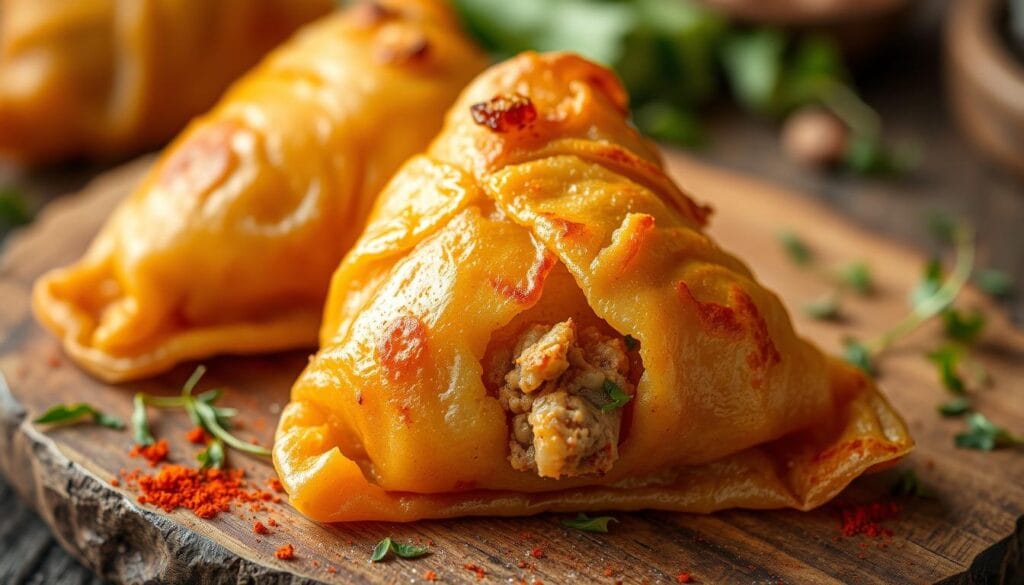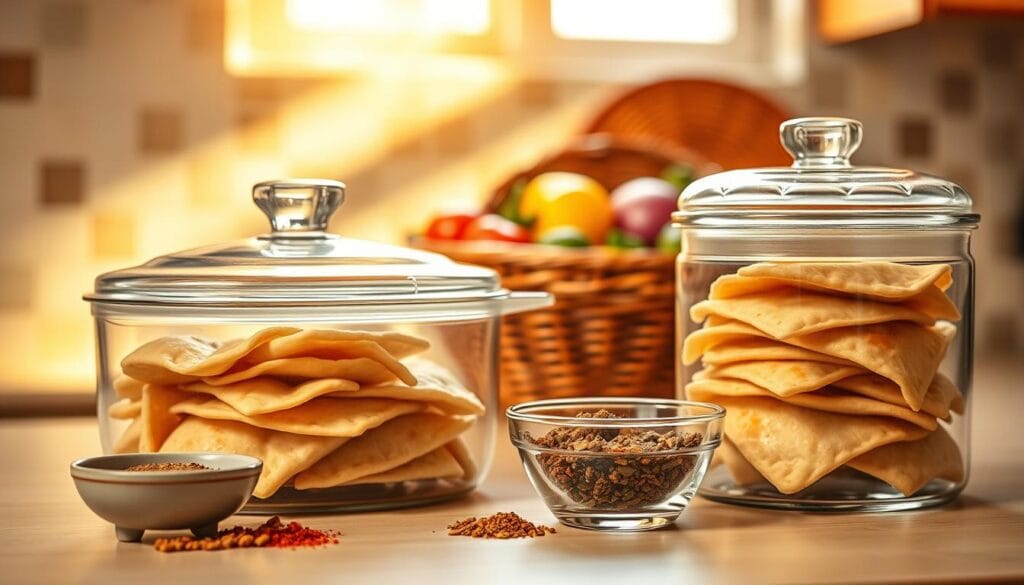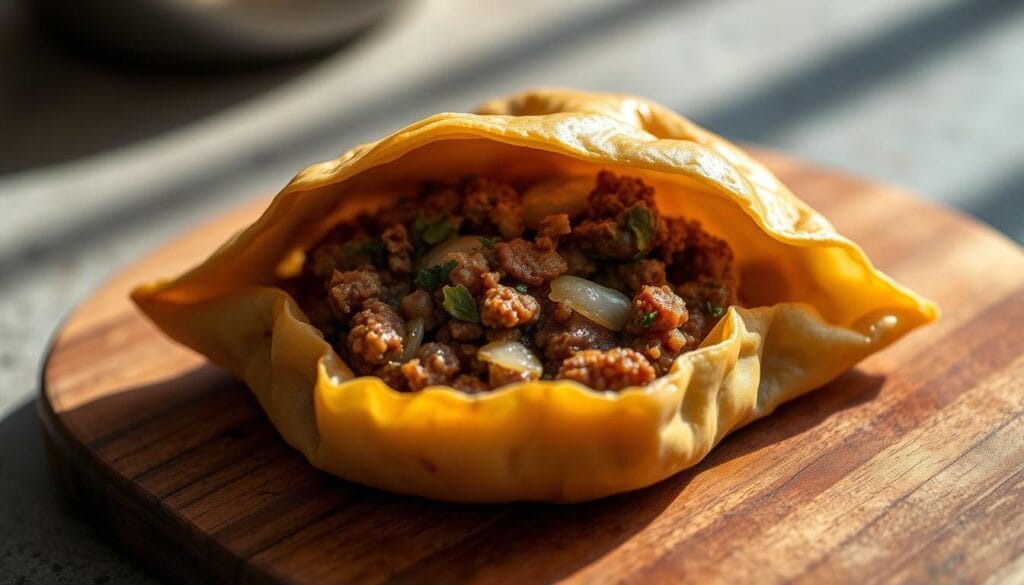When I first learned to fold sambusa, the scent of cumin and coriander wrapped around me like a familiar embrace. Growing up, these crisp triangles were always at the heart of family meals—a shared joy passed down through generations. Now, I’m excited to share this East African food tradition with you.
Imagine your kitchen filled with the warmth of golden-brown appetizers just emerging from the pan. That’s the magic of sambusa—crispy pockets holding stories of community and flavor. Whether you’re new to African cuisine or eager to recreate a cherished memory, I’ll walk you through every step. Together we’ll turn simple ingredients into something extraordinary, bite by crispy bite.
This isn’t just a recipe—it’s an invitation to savor the traditions that make East African food so special. Let’s create moments that linger long after the last sambusa disappears from the plate.
FAQ
What exactly is sambusa?
Sambusa, also known as samosa, is a savory pastry from East Africa. It’s a meat-filled triangle, often deep-fried and spiced. It’s a great halal snack or appetizer.
Are there traditional fillings for sambusa?
Yes! Traditional fillings include spiced ground beef or lamb. You can also use chickpeas, lentils, and veggies for a vegetarian option. The spices should reflect Somali cuisine’s rich flavors.
Can I bake sambusa instead of frying them?
Absolutely! Baking is a healthier option. Bake at 375°F (190°C) until golden brown. It keeps the flavor wonderful without the extra fat.
How do I ensure my sambusa dough is perfect?
Perfect dough is about balance. It should be smooth and pliable but not sticky. Resting the dough helps make it easier to shape.
What are some common mistakes to avoid when making sambusa?
Avoid overfilling, which can cause bursting. Also, don’t roll the dough too thick or thin. Aim for 1/8 inch thickness for the best texture.
How should I store leftover sambusa?
Store leftover sambusa in an airtight container lined with paper towels. They stay crispy for 3-4 days in the fridge. Freeze them before cooking for up to 3 months.
Where can I find authentic sambusa in the US?
Find authentic sambusa at East African restaurants in cities like Minneapolis and Washington DC. Halal markets also offer freshly made sambusa as a snack.
Can I involve my family in making sambusa?
Yes! Making sambusa is a great family activity. It creates connections and memories. Try having a “sambusa Sunday” where everyone helps out. It’s a fun way to share traditions and bond.
What is Sambusa?
Thinking of Somali cuisine makes me think of sambusa. It’s a traditional dish filled with history. These crispy pastries are more than food; they connect generations and cultures. Let me tell you why it’s so important in our food traditions.
A Brief History of Sambusa
Sambusa comes from the Middle East and traveled to East Africa. It became a key part of Somali cuisine. Families have perfected the recipe over years, adding spices like cumin and turmeric.
Cultural Significance in African Cuisine
Sambusa is a symbol of unity at weddings and Ramadan iftars. It plays a big role in our traditions:
| Occasion | Role |
|---|---|
| Ramadan | Shared at sunset to break fast with loved ones |
| Festivals | Passed hand-to hand at community gatherings |
“In every fold of dough, I see the hands of my grandmother shaping heritage.” — A family recipe keeper
Sambusa is more than a dish; it’s a way to show love. Its journey from the kitchen to our tables shows how food brings families together.
Ingredients for Sambusa
Every sambusa begins with ingredients that promise warmth and tradition. Let me share what you’ll need to make these savory bites. The foundation starts with basic pantry staples. But it’s the spices and choices you make next that make these pockets memorable.
Essential Ingredients
First, we have the basics. For the dough, you need flour, water, oil, and salt. These simple elements create the crispy shell that holds your filling. The heart of the dish is the filling.
Spices like cumin, coriander, and turmeric add bold flavor. For meat lovers, halal-certified ground beef or lamb ensures authenticity. Vegetarians can choose chickpeas or spinach for a plant-based option.
- Flour, water, oil, and salt for dough
- Ground spices (cumin, coriander, turmeric)
- Halal-certified meat or plant-based proteins
- Onions, garlic, and fresh herbs
Optional Ingredients for Variations
Now, it’s time to have fun and customize your sambusa. Try adding extra spices like paprika or chili flakes for heat. Add raisins or pine nuts for texture.
For halal snack options, use halal-certified cheese or sun-dried tomatoes. My family likes to mix in diced carrots or zucchini for a fresh twist. Play with ratios to balance savory, sweet, and spicy notes.
- Optional spices: smoked paprika, cayenne
- Vegetarian options: roasted red peppers, feta cheese
- Halal-certified fillings like goat cheese or lentils
Take your time choosing ingredients that speak to you. Even small adjustments can make your sambusa uniquely yours. Let’s keep tradition alive while making it your own.
Preparing the Dough
There’s a quiet joy in shaping dough that becomes the soul of any savory pastry. It’s like nurturing a seed into bloom. The dough needs care to hold the flavors we’ll soon wrap inside. Let’s start by choosing your base.
Choosing the Right Flour
Think of flour as your dough’s backbone. Here’s what works best:
| Type | Texture | Best For |
|---|---|---|
| All-purpose flour | Mild elasticity | Classic sambusa texture |
| Bread flour | Sturdy, chewy | Craving a heartier savory pastry crust? |
Tips for Perfect Dough Consistency
My go-to steps:
- Add water one tablespoon at a time—dough should cling to your fingers without sticking.
- Cover the bowl with a warm kitchen towel. Let it rest 20–30 minutes so gluten relaxes.
- Knead gently—overworking tightens the dough, making it tough.
Remember, dough whispers its needs through touch. If it feels dry? Add a splash. Too sticky? Dust with a pinch of flour. This partnership teaches patience—one of cooking’s sweetest lessons.
Popular Filling Options
Choosing the right filling is like wrapping a hug inside each sambusa. Let your creativity guide you—here are three flavorful choices to try.
Every meat-filled triangle deserves a bold flavor foundation. For the Spicy Ground Beef Filling, start by sautéing beef with caramelized onions. Add garlic, ginger, and a pinch of cayenne for a kick that warms the soul.
- Vegetarian Chickpea & Spinach: Mash chickpeas with wilted spinach, turmeric, and lemon juice for a protein-packed option.
- Cheese & Herb: Mix shredded mozzarella, feta, and fresh herbs like dill. For ideas on balancing flavors, explore beef burger inspiration to adapt spice blends.
| Filling | Key Ingredients | Style |
|---|---|---|
| Spicy Beef | Beef, cayenne, ginger | Fiery & classic |
| Chickpea | Cooked spinach, turmeric | Plant-based comfort |
| Cheese & Herb | Mozzarella, dill | Creamy & bright |
Experimentation is key—we’ve crafted unexpected combinations like adding apricots to savory beef for sweet-savory depth. What’s your signature touch? Let your fillings tell your story.
How to Shape Sambusa
Folding Sambusa into their signature shape is a quiet joy. It’s like a cozy ritual, with your hands moving in rhythm. The shape is not just for looks; it makes sure every bite is full of flavor.
Traditional Triangular Shape
Begin by rolling dough into circles, about 3 inches wide. Fill them with your favorite mix, like a meat-filled triangle or veggie blends. Then, fold them gently. Here’s how:
- Place dough on a floured surface, add a spoonful of filling in the center.
- Brush edges with water to seal, then fold into a half-moon. Pinch edges to create pleats.
- Flip and press to form a triangle, ensuring no air pockets trap steam.
Alternative Shapes to Try
Once you’ve mastered the classic, try new shapes! Shapes like rectangles or crescents add a playful twist. Here’s how they compare:
| Shape | Best Filling | Texture |
|---|---|---|
| Rectangle | Vegetarian blends | Crispier edges |
| Half-Moon | Meat-filled triangle | Soft center, crunchy tip |
Every fold has a story. Whether for a family gathering or a potluck, patience is key. Let your hands guide you—the dough will adapt as you learn. And don’t worry if the first few are lopsided; by the tenth, you’ll find your rhythm.
Frying vs. Baking Sambusa
Choosing how to cook your sambusa is like picking between tradition and health. Both ways bring happiness, but each has its own tale. Deep-fried sambusa is rooted in tradition, while baking offers a lighter, yet still comforting, option. Let’s dive into how to make both options shine.

Benefits of Frying
The sound of deep-fried sambusa in hot oil is unmatched. The golden crust forms a protective layer that stays crisp. I fry at 350°F to cook the dough well without too much oil.
Patience is key: fry each batch just right to get that perfect crunch. This method keeps the filling moist, just like it’s been done for ages.
Healthier Options: Baking Sambusa
Baking gives a lighter touch without losing flavor. At 375°F, the dough browns well and gets a nice firmness. Brushing the edges with a light oil spray before baking helps mimic the deep-fried feel.
This method is a hit with friends, showing you don’t need lots of oil to feel full. Baking also reduces mess and smoke, making it perfect for everyday meals.
Remember, there’s no wrong choice here. Both methods celebrate sambusa’s essence—just like how we all deserve to enjoy food that nourishes us.
Serving Suggestions for Sambusa
Sharing sambusa is more than just serving an appetizer—it’s inviting others into a tradition that’s been cherished in Somali cuisine for generations. Imagine arranging golden triangles on a platter dotted with fresh mint leaves, ready to greet hungry appetites.
Start with sauces that dance with the flavors of your sambusa. A creamy yogurt sauce blended with cucumber and fresh dill adds a cooling contrast to spicy fillings. Or try a zesty tomato relish with a dash of lemon—both simple to make and deeply satisfying.
- Classic choices: Mint-yogurt dip, tangy tamarind sauce
- Zesty options: Cilantro-lime chutney, harissa drizzle
Pair your appetizer with dishes that echo its heritage. Think fluffy basmati rice tossed with toasted almonds or a crisp green salad with citrus vinaigrette. For heartier meals, serve sambusa alongside lentil stew or roasted vegetables.
Don’t forget beverages! A glass of spiced chai or mango lassi balances the heat and richness. These little pockets of flavor become even more special when shared—like a warm embrace from a shared table.
Whether you’re hosting a dinner or a casual snack time, sambusa shines as a bridge between cultures and flavors. Let your guests dip, crunch, and savor each bite. After all, every appetizer tells a story—and yours is waiting to be tasted.
Storing Leftover Sambusa
Keeping leftovers fresh is key to enjoying East African food traditions. Proper storage keeps your homemade traditional dish crisp and tasty. This is true whether you’re saving some for tomorrow or planning a future feast.

Always let your sambusa cool down before storing. Moisture can ruin that golden crunch we love. Here’s how to keep your treats fresh:
- Refrigerate in an airtight container lined with paper towels to absorb extra oil.
- Stack them in a single layer if possible—this prevents sogginess.
Freezing is great for longer storage. Freeze uncooked sambusa on a tray first to prevent sticking. Once solid, store in freezer-safe bags. When you’re ready, bake from frozen for that crispiness.
“Freezing uncooked is like preserving a moment of love for future meals.”
For cooked sambusa, wrap each one individually, then group in a container. Reheat at 350°F (175°C) for 10-15 minutes. This brings back their vibrant taste. These steps keep East African food traditions alive, even on busy days.
Common Mistakes to Avoid
Every cook has a story about their first burnt sambusa or a dough that refused to hold together. Let me share tips to help you skip the stumbles and embrace the joy of perfect savory pastry every time.
One frequent slip-up? Overstuffing the pockets. Think of your savory pastry like a overstuffed suitcase—too much and it bursts! I recommend 1-2 tablespoons of filling—enough flavor without risking leaks during deep-fried cooking.
- Overfilling: Excess filling causes tears while folding or greasy messes when deep-fried.
- Dough texture: Too thick = dense pockets. Too thin = fragile shells. Aim for translucent yet sturdy dough (see-through when held to light).
Oil temperature matters most during deep-fried prep. Here’s the sweet spot:
| Oil Temperature | Result |
|---|---|
| 350°F-375°F | Crisp golden savory pastry |
| Below 350°F | Greasy, soggy texture |
| Above 375°F | Charred outsides, raw insides |
Remember: Practice builds muscle memory. If your first batch isn’t perfect, celebrate the lesson—it’s part of our shared journey toward perfecting this cherished tradition. We’re here cheering you on every step of the way!
Enjoying Sambusa in the US
Sambusa is more than a recipe; it’s a story to share. In the United States, it connects cultures with its delicious flavors. It’s a way to experience East African traditions right here.
Where to Find Authentic Sambusa
Looking for a halal snack that’s true to its roots? Visit areas with Somali, Ethiopian, or Eritrean communities. In cities like Minneapolis, Columbus, Seattle, and Washington DC, you’ll find it. Local eateries and halal markets serve it fresh every day.
These places use recipes passed down through generations. It’s perfect for when you want the real taste without cooking it yourself.
Making Sambusa a Family Tradition
Bringing sambusa into your home makes cooking a family affair. In Chicago and Atlanta, families make it a weekly tradition. Kids help shape the dough, while elders share stories of its origins.
It’s not just a meal; it’s a way to connect with your heritage. Whether it’s for holidays or a simple weeknight dinner, sambusa brings everyone together.
Every bite of sambusa carries the love of generations. By enjoying it, we celebrate its journey from East Africa to America. Whether you buy it or make it yourself, sambusa reminds us that food connects us all.
We are interested in your feedback
Catchy recipe
Sounds delicious
Original idea
Yummy
Healty and nutritious
Well done
Interesting
Just good

